Menu

Did you know the global agri-food system creates 31% of all human-related greenhouse gas emissions? Farming has a huge impact, making up over a quarter of the world’s emissions. With food demand set to rise by 56% from 2010 to 2050, it’s vital we address farming’s carbon footprint.
The farm carbon footprint is the total amount of greenhouse gases from farm activities. It includes things like livestock, fertilisers, and energy. This issue isn’t just in books; it affects global warming and the earth’s condition. But, farmers can do a lot to help. They can use practices that store carbon and manage their resources well. This lowers farming’s bad effects on the planet and helps reach climate goals.
The United Nations wants the world to produce zero net greenhouse gases by 2050. The farm sector needs to cut emissions by 45% by 2030 to stop the earth from getting more than 1.5 degrees hotter.
The idea of a farm carbon footprint is all about the impact farms have on the environment. It’s crucial for today’s farms to focus on being sustainable. This means dealing with the big issue of greenhouse gases. These gases come from lots of things in farming, like machinery and animal waste.
Farmers and others in the agri-business world must get the farm carbon footprint. It helps them see how their work affects the planet. Knowing this, they can then find ways to cut down those harmful gas emissions.
They can do this by doing things such as planting more cover crops and keeping the soil healthy. To add, using certain farming methods, like carbon farming, can actually lower the bad gas emissions.
The farming industry faces lots of problems when it comes to the environment. One big issue is using too many fertilisers, especially the nitrogen ones. This leads to a lot of nitrous oxide, which is a powerful greenhouse gas.
There’s also the problem of soil being washed or blown away. This not only makes the land less productive but also lets the carbon it stores escape into the air. Another big issue is the methane from animals. Finding new ways to feed them and deal with their waste can help with this.
There’s a system called Carbon Farming that can help tackle these problems. It’s backed by governments and is about using farming methods that not only keep carbon in the ground but also help the soil and wildlife. This approach is key for farming to help the planet and still be successful in the future.
| Challenges | Potential Solutions |
|---|---|
| Overuse of fertilisers | Optimised fertiliser application using drone technology |
| Soil erosion | Implementing no-till and cover crops practices |
| Methane emissions from livestock | Use of feed additives and anaerobic digesters |
Looking after the soil is crucial for cutting down emissions. This is done by using cover crops and improving the soil’s organic matter. These steps help a lot in making farming more sustainable and fighting against climate change.
Cover crops, like clover and rye, are important in soil management. They cover the soil between main crop seasons and add organic matter to it. This boosts soil health and keeps carbon in, reducing harmful emissions. By using cover crops, we help take a big step in the right direction against climate change.
It’s key to disturb the soil less to manage it well. Traditional ways of tilling the soil can damage its structure and release carbon. Conservation tillage and no-till methods try to disrupt the soil less. Even though their effect on lowering carbon emissions is still being studied, they are crucial for good soil health. This keeps the carbon where it belongs, in the soil.
Using these soil management techniques helps lower emissions in farming. This step is essential for a better, sustainable future.
The agriculture sector makes up 60-70% of nitrous oxide emissions globally. Nitrous oxide is much worse for our climate than CO2, with a 265-298 times greater warming potential. To tackle this, we need to use less fertiliser, employ drones in farming, and grow more cover crops like legumes. These methods have shown they can lower nitrous oxide levels and keep our soil healthy. These are all key steps in the right direction for our planet’s future.
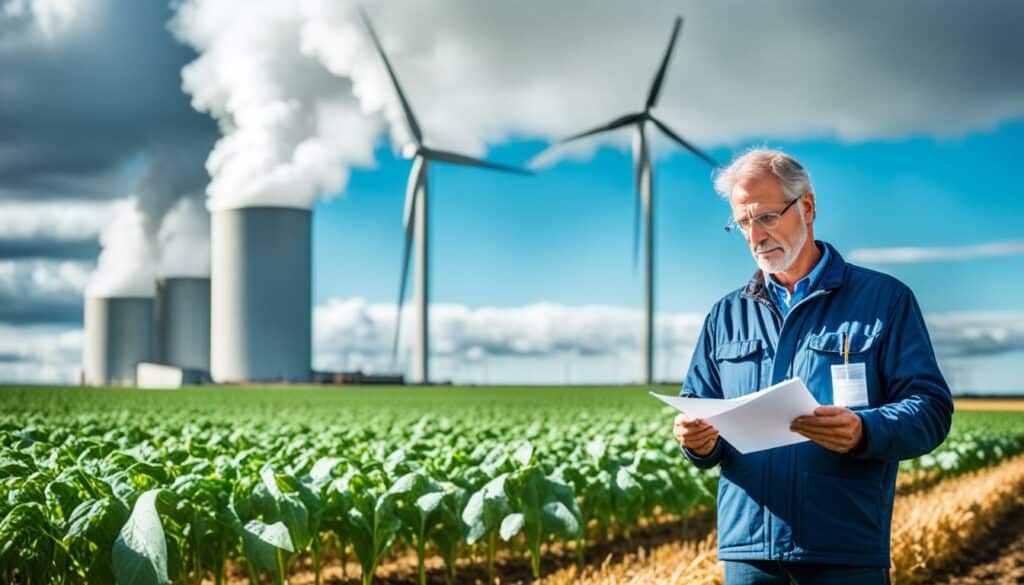
Getting the right amount of fertiliser on fields is a big part of reducing emissions. Instead of using a lot of fertiliser, farmers can work out how much nitrogen their crops need. Then, they can apply the exact amount. This not only cuts down on harmful emissions but also helps crops grow better and soil stay healthy. Using less nitrogen in big crop areas or spreading out when the fertiliser is used can really help.
Precision agriculture is an advanced way to lower nitrous oxide levels. Drones can fly over fields, checking the soil’s nitrogen levels to see where fertiliser is most needed. This smart farming method aims fertiliser only where it’s truly needed. It’s a win for the environment. Precision agriculture is being used around the world. For instance, Western Australia has seen great success. Even though they don’t get as many benefits from saving credits, they still do a lot to protect the environment.
Planting legumes as cover crops is a smart move. They cut down on the need for artificial fertilisers by adding nitrogen to the soil naturally. Studies show that using natural, bio-based fertilisers is good for the planet. Seleiman et al. (2012) showed that using sewage sludge on certain crops has big environmental payoffs. Plus, growing legumes boosts soil quality and makes farming more sustainable.
| Strategy | Implementation | Impact on Emissions |
|---|---|---|
| Optimising Fertiliser Application | Smaller, targeted applications | Significant reduction |
| Precision Agriculture | Drone-based remote sensing | Minimises over-fertilisation |
| Legumes as Cover Crops | Natural soil enrichment | Reduces synthetic fertiliser need |
Livestock farming, mainly cows and sheep, produces a lot of methane. To lower these harmful gases, we need to use a mix of methods. This includes changing how we feed the animals and improving how we handle their waste.
Adding special things to the animals’ food can help cut down on methane. These changes in diet can make the animals release less gas. But, it’s also important to make sure these changes don’t harm the animals.
Dealing with animal waste well is key too. Using methods like anaerobic digestion can reduce methane a lot. This process turns manure into biogas, a cleaner form of methane. It’s shown to lower the total methane coming from farming.
Another good move is to avoid spreading manure every day. Instead of using open lagoons, keeping it covered can help. Also, letting animals graze more can lower methane from their waste.
Turning animal waste into compost helps too. This makes less methane than when it just piles up. Such changes can cut the amount of harmful gas being released into the air.
In parts of Australia, like New South Wales, livestock are the main source of agricultural emissions. By managing how we take care of them, we can lower their gas output. This involves methods such as picking animals that don’t produce as much methane.
Reducing methane isn’t just about helping the environment. It’s also key to making farms more stable and sustainable. Tackling these emissions is a big step towards a farming sector that is greener and stronger.
Anaerobic digesters are a smart way to deal with methane, which comes from manure getting broken down. They help turn waste into energy and stop water pollution. But, it’s key to know how these systems work for them to be used right in farming.
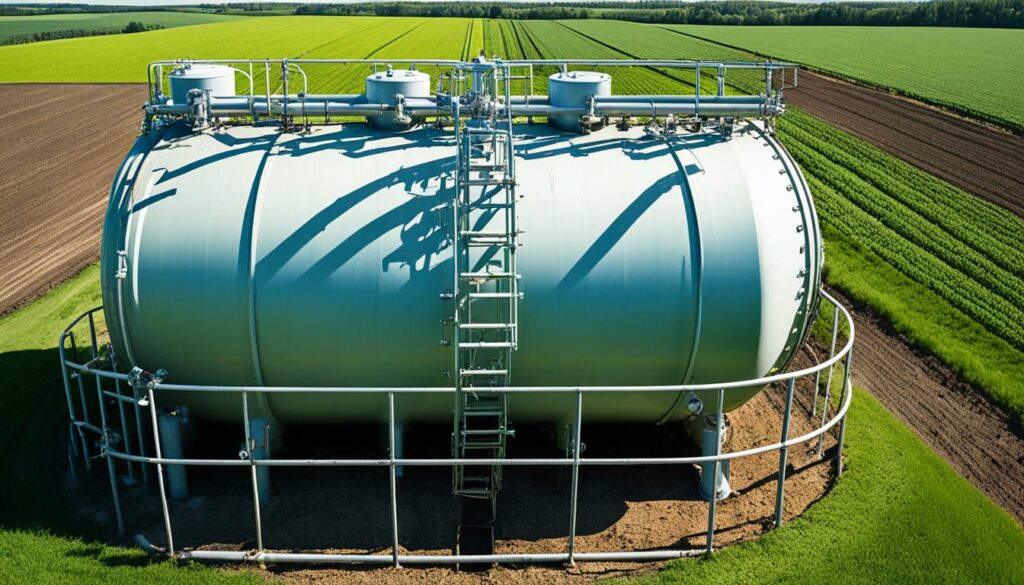
These digesters process organic stuff without air, making biogas that can be used for power. If used for making electricity, they need to tackle air pollution issues. This means dealing with hydrogen sulfide and making sure engines’ exhausts are clean.
It’s also important to follow the rules, like getting an Air Permit to Construct. This is critical for engines that are 100 bhp or more.
Using anaerobic digesters for biogas is not straightforward when it comes to money. Building them costs a lot, and biogas doesn’t have as much energy as natural gas. They must tackle hydrogen sulfide and meet emission standards.
But, in the long run, they’re great for cutting down farm emissions and the state’s greenhouse gases. Plus, applying for permits costs no more than $1,000 by Act 77 of 2017. So, these digesters can really help the farming industry grow in a sustainable way.
It’s crucial to cut greenhouse gas emissions in farming. The agri-food system makes up 31% of global human-made emissions. As food demand grows, we must use climate-smart methods.
Using eco-friendly farming is vital for reducing the harm agriculture does to the planet. Crop rotation, managing pests without harmful chemicals, and using water wisely are key. They help lower around 6% of emissions made during farming, which mostly come from using fuel.
Climate-smart farming doesn’t just lower emissions; it also helps the planet. It focuses on keeping a variety of plants and animals, keeping the soil healthy, and using less fossil fuel. These steps are part of a push to reduce emissions by 45% by 2030, and help fight global warming.
Measuring emissions with CO2e helps farmers see how their actions affect the environment. This is a useful tool for making better choices.
Also, cutting down fewer forests and watching how they break up can protect many plants and animals. We must know how fast forests are disappearing and what shape they’re in to save them. Doing so, along with using green farming techniques and climate-smart methods, ensures we can meet food needs without harming the Earth.
Urban agriculture plays a big role in the shift towards sustainable agriculture. It brings benefits like producing food locally and getting communities involved. Yet, we need to look closely at its carbon footprint.
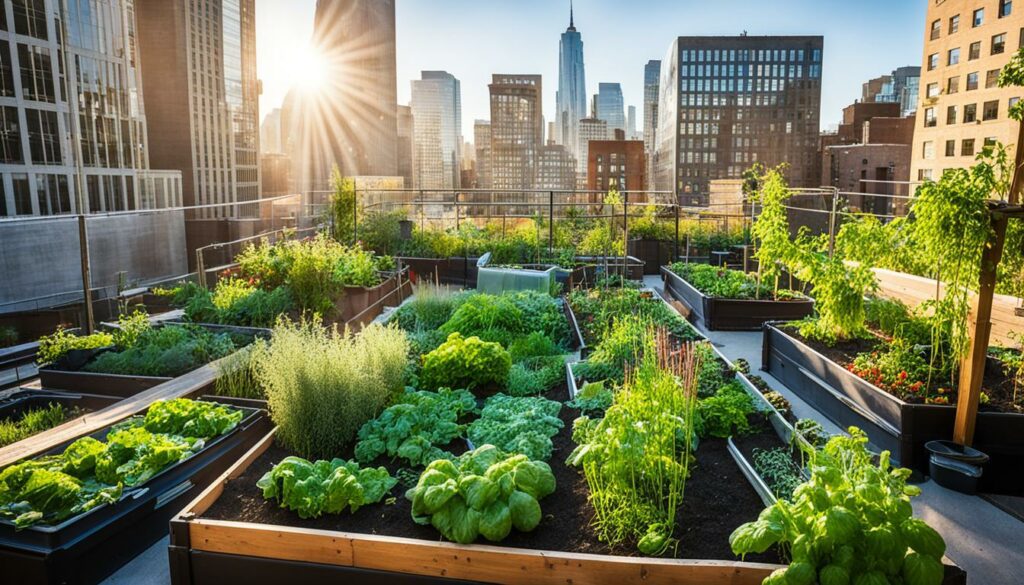
When we compare urban agriculture to traditional farming, we have to think about carbon emissions. Generally, producing food in cities leads to six times more emissions than usual farming. This comes to 420 gCO2e per serving, way higher than the 70 gCO2e from conventional farming.
City collective gardens produce the most emissions, at 0.81 kgCO2e per serving. But, urban farms can be as good as regular farms in reducing emissions, down to just 0.08 kgCO2e per serving in some cases. These figures show urban agriculture works well under the right conditions.
| Type | Footprint (kgCO2e per serving) |
|---|---|
| Collective Gardens | 0.81 |
| Individual Gardens | 0.34 |
| Urban Farms | 0.34 |
| Conventional Farms | 0.07 |
The emissions from urban agriculture change depending on the country. For example, Poland has the lowest impact, while the UK has the highest. Even among 73 urban farms, 17 were better for the environment than traditional farms.
Despite the higher carbon footprint, urban agriculture is good for the planet and society. It cuts down on the emissions from moving food long distances. Sustainable agriculture methods, such as using city waste for compost, also help.
There are challenges, like needing lots of buildings and more energy. Yet, these can be tackled. Choosing the right crops and causing less harm to the land can make urban agriculture greener. This way, it can be part of reaching carbon-neutral agriculture.
To sum up, the carbon footprint of urban agriculture is high, but we can reduce it. By using smart methods and sticking to sustainable agriculture ideas, urban farmers can aim for zero emissions. This would support the broader goal of global sustainability.
Advanced technology can be a game-changer in managing and cutting down farm carbon footprints. Precision agriculture uses tools like GPS, sensors, and drones to better manage resources. This lets farmers make choices based on exact data, which leads to cutting down on emissions.
The Internet of Things (IoT) is key in making farms run more efficiently. It helps with things like smart bio-fertilisers that stop too many nutrients from being used. This combo of IoT and bio-fertilisers shows how smart tech fits into agriculture.
Seitan, a meat-free choice, is another way to reduce emissions. Its carbon footprint is much smaller than beef. So, pushing for diets that use less meat can really cut down on methane in the air.
| Technology | Impact on Emissions |
|---|---|
| GPS and Drones | Optimise resources, minimise waste |
| IoT | Monitor shelf lives, reduce food waste |
| Smart Bio-Fertilisers | Prevent overapplication, reduce pollution |
| Vertical Farming | Minimize transportation emissions, enable local produce |
Smart tech is crucial for eco-friendly farming, not just for cutting down on work. For example, vertical farms grow food locally, reducing travel emissions. And using methane inhibitors can also lower the gases cows produce, helping to trim down on emissions.
Carbon sequestration is key in fighting climate change. It captures CO2 from the air, storing it in the soil. This process cuts down on harmful emissions, boosts soil quality, and improves crop yield. It’s a big win for the planet and farmers alike.
Carbon sequestration is about locking carbon in the ground for a long time. It’s part of clever farming that’s good for both crops and nature. The U.S. Department of Agriculture says American soils could take out 250 million tons of CO2 each year. This is a major help in lowering the country’s greenhouse gases.
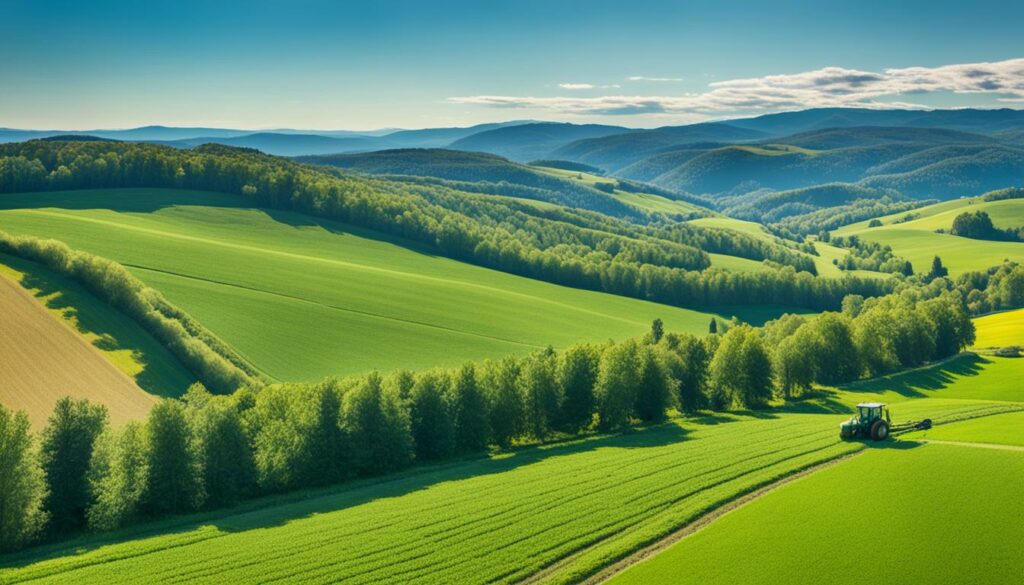
Some farm methods really ramp up carbon storage. Things like no-till farming, cover crops, and growing trees can do a lot of good. Take Maryland’s Trey Hill, for example. He made $115,000 by capturing 8,000 tons of carbon. If he stores a bit more on his land, he could make $150,000 yearly.
| Sequestration Technique | Benefits | Potential Earnings (Annual) |
|---|---|---|
| No-till Farming | Reduces soil disturbance and retains carbon in the soil. | $30-$45 per acre |
| Cover Cropping | Improves soil organic matter and prevents erosion. | $15 per MT of CO2e |
| Agroforestry | Incorporates trees and shrubs into farming systems. | Varies based on carbon market prices |
The market for farming carbon credits is now worth $5.2 billion. It grows with every investment in sustainable farming. Initiatives like Indigo Ag are getting more and more farmers involved. New tech also makes it easier to track and get paid for storing carbon in the soil.
Looking towards the future, making agriculture carbon-neutral is a key aim. This involves balancing out the greenhouse gases released with ways to capture or reduce them. It’s achieved by using renewable energy, becoming more energy efficient, and trading in carbon. This way, farming can be both sustainable and ready for the changes in our climate.
The big goal for carbon-neutral farming is to offset the amount of greenhouse gases we produce. In simple terms, it means making sure that in the end, farms don’t add to pollution. They might even help take some pollution out of the air.
To reach carbon-neutral, several important steps must be taken. Switching to power from the sun and wind is a start. Then, making farm activities use less energy helps a lot. Finally, there’s carbon trading. This means investing in projects that help the environment to balance out any gases we can’t avoid.
In California, for instance, many districts are already working hard to be carbon smart. They’re using special farming methods that not only cut down on pollution but have other good effects too. These include better crops, using less chemical fertilisers, and keeping water in the soil. They are also stepping stones to making farming more sustainable.
The long-term goal is big: by 2045, California aims to capture over 25 million tons of CO2 every year. This shows how much good these efforts can do. Just think, removing a million tons of CO2 is like taking 215,000 cars off the road each year. It proves the power of these actions.
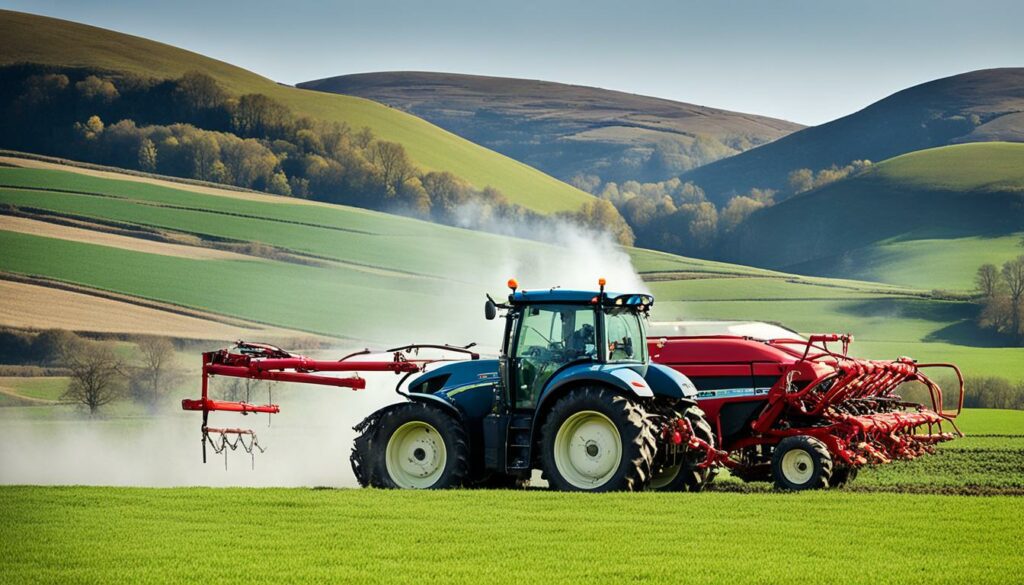
Focusing on reducing the *environmental impact* of farming equipment is key to encouraging sustainable farming. Using machinery that’s energy efficient helps lower the carbon footprint of farming.
*Agriculture companies* embracing methods with a smaller carbon footprint tend to be more efficient. They also make better use of resources. Shifting to green energy sources for farm machines can cut carbon emissions and save money in the long run.
Precision farming uses advanced methods to reduce emissions. It involves placing resources exactly where they’re needed to decrease waste. Technologies like GPS and automated systems boost efficiency. This helps reduce the impact of farming on the environment.
*Regular maintenance* is key for farm equipment. When machines are well-maintained, they use less fuel and emit fewer greenhouse gases. They also work better for longer.
Switching to cleaner fuels or electric farm equipment helps cut the carbon footprint. Also, new tech like carbon capture can lower CO2 emissions. It does this by capturing the emissions before they can enter the atmosphere.
Additionally, rotational grazing and better ways to manage livestock can lower methane gas from digestion. Using fewer synthetic chemicals in farming helps, too. It cuts the amount of these chemicals that end up in our water.
Teaching farmers and agriculture experts about sustainable methods is crucial. When more people use these methods, it makes a big positive impact on the environment.
| Strategy | Impact | Benefit |
|---|---|---|
| Energy-efficient Machinery | Lower Fuel Consumption | Reduced Emissions |
| Renewable Energy Sources | Lower GHG Emissions | Long-term Savings |
| Precision Agriculture | Optimised Resource Use | Minimal Waste |
Using sustainable farming methods brings big, lasting benefits. It helps agriculture fight climate change and protects nature. Things like organic farming, saving soil with zero-till, and mixing livestock can boost plant and animal life. They also make soil healthy and save water. Many studies show these methods can help the planet and make farming more profitable.
Sustainability in farming focuses on the earth’s health. Things like changing crops, adding cover plants, and not tilling the soil are good for the land. They use nutrients better and stop soil from washing away. Farming can make a lot of greenhouse gases. So, it’s important to farm in ways that cut down on these gases. In the U.S., there’s a goal to farm greener and cut emissions by 40% before 2050.
Farming in smart ways can also save water and make plants stronger. There’s a new interest in buying and selling carbon to reduce emissions. This lets farmers make money by helping the planet. They can earn around $15 for each ton of CO2 they save. This is good for both the earth and the farmer’s wallet.
There are stories about farms that have done very well using smart farming. In Iowa, some farmers have cut a lot of CO2 from the air and made money from it. They made between $30,000 to $45,000 by doing so. Programs that pay for these good efforts help prove that green farming makes sense.
Also, many companies plan to set a price on their carbon output soon. This shows they care about the environment. The food and drink industry leads in wanting to buy carbon credits. This means there is a big market for doing farming that saves the planet.
Switching to green farming can make a big difference. It not only helps the planet but opens new earning opportunities for farmers. They can do their part for the planet and make more money. This makes farming stronger for the future.
Knowing the farm carbon footprint is vital for eco-conscious farmers. They use carbon calculators to measure and control their emissions. This helps them farm in a more planet-friendly way.
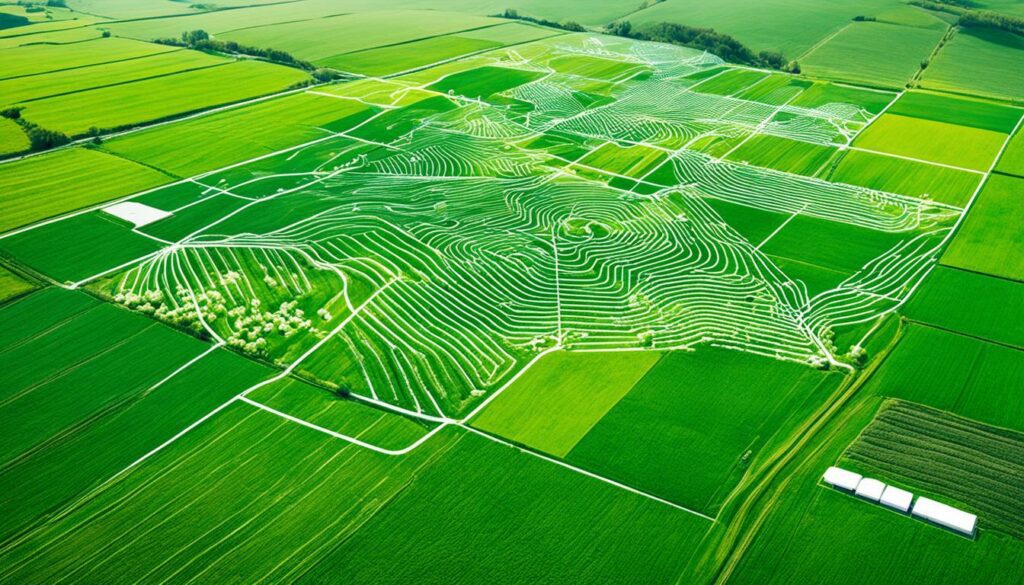
The Farm Carbon Calculator is a top tool for this job. It fits all kinds of farming, like raising animals or growing crops. Best of all, it’s free and covers everything from using fuel to how your animals affect the air.
| Feature | Description |
|---|---|
| Time for Data Collection | 2-3 hours to a whole day, depending on business complexity |
| Time for Data Input | 30 minutes to 2 hours |
| Emissions Assessed | Fuels, electricity, business travel, materials, machinery, livestock, waste, and recycling |
| Greenhouse Gases Tracked | CO2e, N2O, CH4 |
| Report Updates | Twice a year |
With the right reports, farmers can see where their farm pollutes the most. This helps them focus on cutting down emissions effectively. Their farm’s eco-friendliness gets better over time.
Reports from carbon calculators are full of valuable info. They show the biggest pollution problems and detail what kinds of gases are being put out. This includes how livestock contributes, like the effects of how manure is handled.
Accuracy is key in all this. It makes sure pollution levels are not wrongly high or low. Plus, the tool always stays up to date with the latest info. This way, farmers are always using the best methods to be greener.
Using the Farm Carbon Calculator truly helps. It allows farmers to be better in all they do, from how they grow food to how they treat the environment. This is a big step towards a farming future that’s good for our planet.
We’re making big strides to lower farm carbon footprints. This is crucial for our farming future and the planet’s health. It’s key to know how much farming and forestry add to greenhouse gases in the US. Changing to sustainable methods can lessen these effects. This also boosts farm productivity.
Cutting down on fossil fuel emissions is vital. They make up 80% of US emissions. Farming uses only a bit of this, but it’s still important. Farmers can help by growing crops for biofuels. They can also use wind and solar energy. This reduces pollution from farming.
Using smart farming helps the environment. Methods like conservation tillage and keeping soil healthy hold carbon. This lowers harmful gases in the air. Things like trading pollution rights and rules for biofuels give farmers a reason to try these methods.
Looking back on reducing farms’ carbon footprint, progress is evident. Using new tools like carbon calculators is making a big difference. The goal is clear with everyone working together: make farms carbon neutral and ready for the future.
A farm’s carbon footprint is the total greenhouse gas emissions it produces. This includes gases from livestock, using fertilisers, and energy. It’s important to understand and lower this footprint. This is key in fighting global warming and protecting the environment.
The agriculture sector deals with many issues. Overusing fertilisers, soil erosion, and methane from animals are big problems. To tackle these, we need new farming methods. These must be both innovative and kind to the environment.
Using cover crops and improving soil matter can help lock away carbon dioxide. Keeping the soil undisturbed also helps. This is called conservation tillage. It keeps carbon in the ground. However, scientists still discuss how well it works.
We can lower nitrous oxide emissions by using fertilisers more efficiently. Also, using high-tech drones for farming can help. Planting legumes as cover crops is great too. They add natural nitrogen to the soil. This means less artificial nitrogen is needed.
For livestock, using specific feed additives might reduce how much methane they make. Properly handling manure is also important. Plus, using anaerobic digesters can help lower emissions even more.
Anaerobic digesters transform manure into biogas. This is a renewable form of energy. They also lower the risk of water pollution. But, setting up these digesters can be expensive. And the energy they produce might be less than normal gas.
To cut greenhouse gases, farmers can use eco-friendly techniques. They can also turn to smart farming methods. These include growing different crops and managing pests carefully. Saving water is also crucial.
Urban farming might sometimes use more carbon than usual farms. But in certain conditions, like when using city waste, it’s very beneficial. This approach can be as good as, or better than, traditional farming. It provides food in a way that’s sustainable for the earth.
Precise agri-tech like GPS and drones can help farms use resources better. They cut waste and gather important data for managing carbon emissions.
Carbon sequestration takes carbon dioxide from the air and stores it in the soil. Ways to do this include planting trees and not tilling the soil. These methods are good for the environment and help farms be more productive.
Carbon-neutral farming aims to balance the greenhouse gases farms produce. This is done by using clean energy, being energy-efficient, and trading carbon. It’s a way to farm that doesn’t harm the planet.
To lessen the impact of farm machines, choose energy-saving ones and keep them well-maintained. Using technology like GPS helps. Moving to cleaner fuels or electric power is also helpful.
Sustainable farming helps the land, water, and wildlife. It makes farms strong and successful. Evidence from around the world proves this. It shows that being kind to the planet is good for business.
There are tools that can calculate your farm’s carbon footprint. They show you where your emissions are high. Then, they help you make choices that are better for the environment. This is key for a sustainable farm.